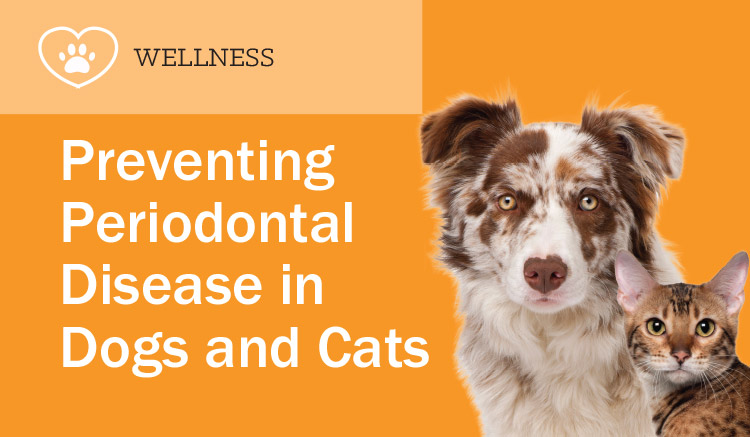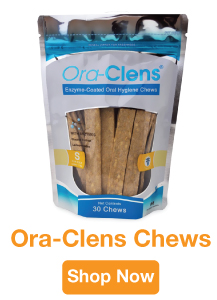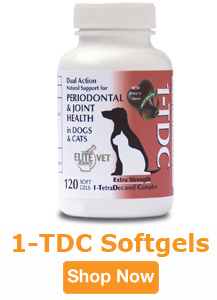
Does Your Pet's Breath Stink? It Could Be Periodontal Disease
We love attention from our petsóbut sometimes getting up close to our animals reveals pungent breath. While halitosis can be addressed with minty treats and other temporary fixes- the true problem is almost never addressed by pet owners. Bad breath is caused by bacteria in your petís mouth that forms plaque and tartar. This process often leads to periodontal disease, a clinical condition that affects 80% of adult cats and dogs.
Bad breath, however, isn’t the only problem associated with periodontal disease- this completely preventable condition can also cause great pain in your petís gums. Even before the disease afflicts your pet, the build-up of tartar has already begun corroding your petís periodontal ligament. If left untreated, the harmful bacteria that have contributed to this tartar build-up can reach your petís blood stream and cause a variety of other serious problems, including early-onset arthritis and heart disease.

What Causes Periodontal Disease?
When food particles are not scraped away from your cat or dogís teeth, they can facilitate the growth and spread of bacteria throughout your petís mouth. Without regular cleaning, these bacteria can adhere to proteins found in saliva to form a thin film of plaque along your petís gums. If this plaque is not scraped off of teeth and gums regularly, it can continue to accumulate and bind with minerals found in your petís saliva to form a hard calculus known as tartar.
Plaque and tartar both secrete acidic compounds that damage enamel and inflame gums. This inflammation is known as gingivitis and is responsible for both bad breath and the reddening of gums. It is essential to treat animals with gingivitis swiftly, as it can still be reversed with proper treatment. Should gingivitis be left untreated, the tartar can spread down your petís gum tissue to form pockets of separation between your petís gums and his teeth. Once these pockets form, they can be exposed to additional bacteria that can create an even more detrimental infection.
This state of infection is known as periodontal disease, and it can lead to the loss of teeth, the creation of abscesses on the gums (stomatitis), and the spread of infections throughout the body. Periodontal disease is irreversible and can only be treated in ways that lessen its impact and slow its progression. Early periodontitis is characterized by swollen, bleeding gums. As the disease progresses, it will also result in the loss of teeth and the formation of pus pockets.
By this point, the only treatment options available to your pet involve preventing the spread of the infection to other areas of the body. This is only possible by performing procedures to remove your petís teeth and infected gum tissue while supplying antibiotics to infected areas to prevent the bacteria from spreading further. These procedures will generally require anesthetics, which can be dangerous to your pet but are also necessary for the procedures that prevent this infection from causing other serious diseases.
How Can I Prevent Periodontal Disease?
Though certain foods can cause plaque and tartar to build up more quickly than others, anything your pet eats will cause the formation of plaque. The only way then to prevent periodontal disease and the gingivitis that precedes it is to regularly clean your pet’s teeth and remove this plaque before it can calcify into tartar. Certain dental treats and rinses can help keep plaque in check, but the best way to prevent the build-up of plaque is with regular brushing.
You can find specialized toothpaste and toothbrushes for cats and dogs to help you clean your petís teeth after meals; however, if tartar has already formed then your pet may require a thorough dental cleaning from a veterinarian. Your veterinarian or dental technician may administer a general anesthetic before the cleansing and then scrape away plaque and calculus with the appropriate dental tool.
Certain dental treats and rinses can help supplement your effort if you find that you are unable to brush your petís teeth adequately. These treats can include minty ingredients that temporarily relieve bad breath with textures intended to help scrape away plaque and tartar. Toys like braided ropes can also help petís scrape plaque off their teeth with natural behavior; however, these solutions are not as effective as brushing and should not be used as a replacement for regular dental cleaning.

How Can I Combat Gingivitis Before It's Too Late?
Though age, general health, diet, and breed are all factors that impact how often your dog needs dental maintenance, itís recommended that most pets have their teeth brushed every two weeks. This is the longest that a cat or dog should go without having his or her teeth cleaned, as tartar can begin to form after only 5 days. Ora-Clens products provide everything needed to combat plaque and tartar in these early stages and can even help once gingivitis has begun to affect your pet.

 Ora-Clens has a comprehensive line of products that include not only toothpastes and toothbrushes for cats and dogs, but also an assortment of dental rinses and treats that can provide supplementary care to your petís teeth and gums. After tartar has formed, your pet is already considered to be in the early stages of gingivitis. Once plaque subverts the gumline, it is considered to be advanced gingivitis.
Ora-Clens has a comprehensive line of products that include not only toothpastes and toothbrushes for cats and dogs, but also an assortment of dental rinses and treats that can provide supplementary care to your petís teeth and gums. After tartar has formed, your pet is already considered to be in the early stages of gingivitis. Once plaque subverts the gumline, it is considered to be advanced gingivitis.
This stage can be identified by a more pronounced redness of the gums as well as some notable swelling. At this stage, your pet needs dental care as soon as possible to prevent its progression to the early stages of periodontal disease. Though some dental rinses and supplements can be effective at treating the early stage of gingivitis, only treatments with 1-TetraDecanol Complex (1-TDC) have been shown in clinical studies to reverse the progression of both stages of gingivitis.
Though 1-TDC has been shown to be effective in these late stages, it is better used as a preventive solution for pets that may just be beginning to exhibit signs of gingivitis. Pets with late stages of gingivitis will almost certainly require professional dental cleaning to prevent the disease from advancing and returning your pet’s mouth to a healthy state. This is due to the fact that when gingivitis has become severe, ultrasonic scalers may be required to break up tartar before it can be scraped away.
Other tools may also be needed to polish the teeth with dental paste and fluoride to prevent the infection from reoccurring. Depending on the severity of the infection, your veterinarian may prescribe antibiotics and even pain relievers for your pet to take before and after the cleaning. This procedure can be painful for your pet and costly to you, so itís recommended that you maintain your petís dental health on a regular basis instead of relying on a dental cleaning when the infection has already occurred. We hope that you take these tips to heart, as providing proper dental care is imperative to your petís overall health.
